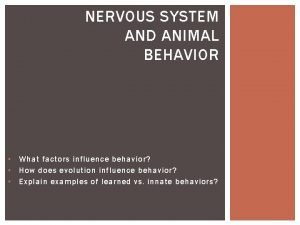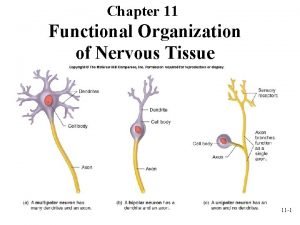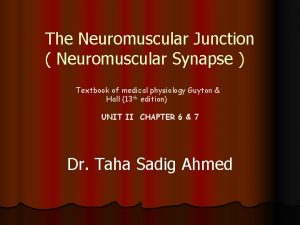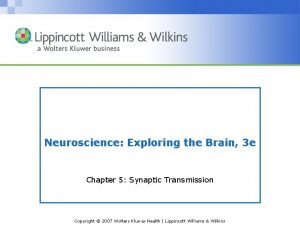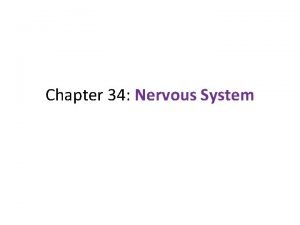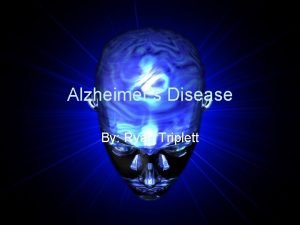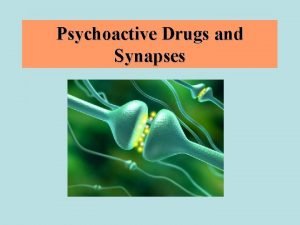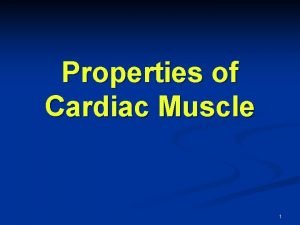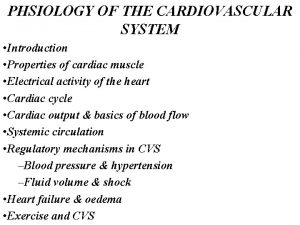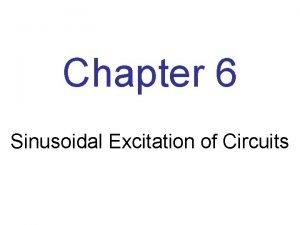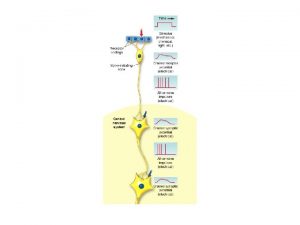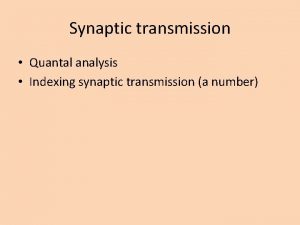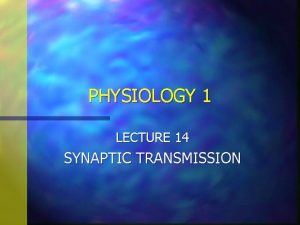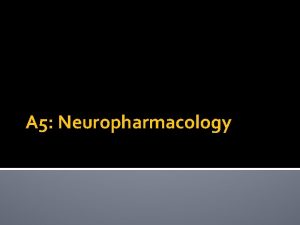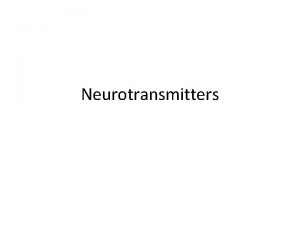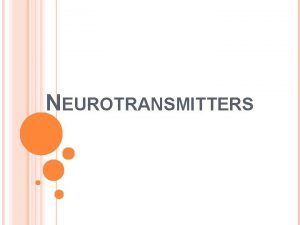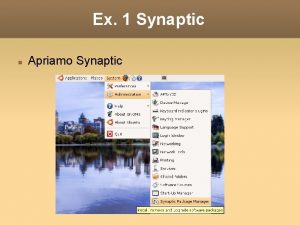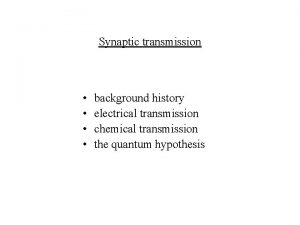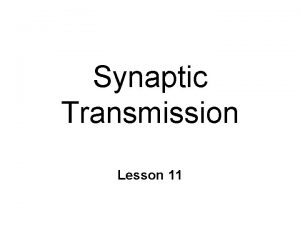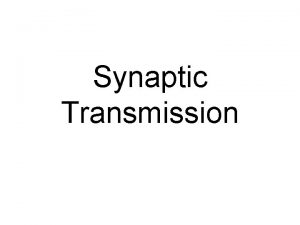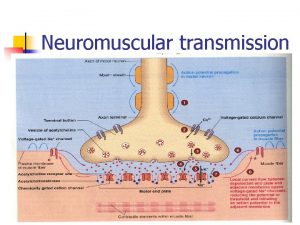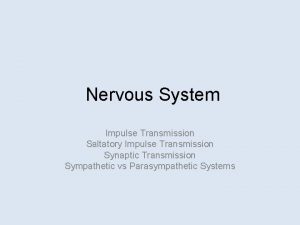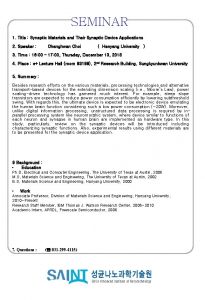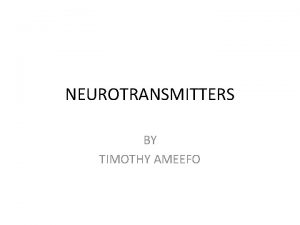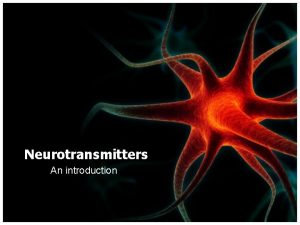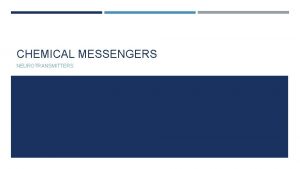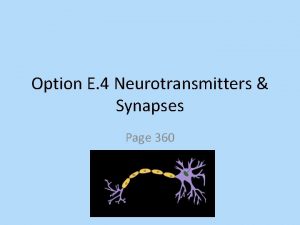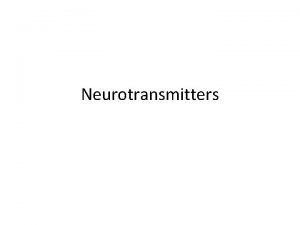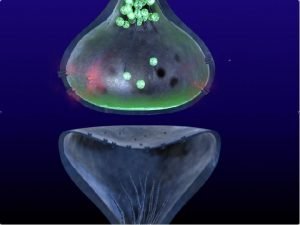The Process of Synaptic Transmission Neurotransmitters Excitation and






















- Slides: 22

The Process of Synaptic Transmission – Neurotransmitters, Excitation and Inhibition Biopsychology

Label your synapse – use these descriptions to increase your knowledge. carries the electrical impulse and is protected by a fatty sheath extend outward from the cell body and are specialized to receive chemical signals from the axon termini of other neurons. Receive signals that trigger an electrical signal. Works like a lock and key These are in the axon terminal and store and release neurotransmitters The space between neurons at a nerve synapse across which a nerve impulse is transmitted by a neurotransmitter brain chemicals that communicate information throughout our brain and body.

Definitions • A neurotransmitter is a chemical released at a synapse. • An example of a neurotransmitter is dopamine • The function of a neurotransmitter is to play an important role in synaptic transmission. As the electrical impulse (action potential) arrives at the axon terminal it cannot cross the gap (synaptic cleft) so a neurotransmitter is released in order to continue the synaptic transmission. • An excitatory neurotransmitter is a chemical that makes it more likely that the post synaptic neuron will fire. • An example is dopamine • An inhibitory neurotransmitter is one that calms the activity in the brain and makes the post synaptic neuron less likely to fire. • An example is GABA

The Neuron • Billions of these in the nervous system • They are the cells of the nervous system • They are specialised to conduct electrical impulses (action potential)


http: //www. bbc. co. uk/schools/gcsebitesize/science/add_ocr_pre_2011/brain_mind/informati onrev 2. shtml

Things to know about the Neuron • Neurons are elongated • Nerve impulses begin in the dendrites • Travel across the cell body to the axon • The electrical impulse is known as an action potential

Synaptic Transmission • Synaptic transmission begins at the dendrite and an action potential goes across the cell body to the axon. It travels down the axon to the axon terminal. Vesicles in the axon terminal store neurotransmitters and the electrical impulse causes these to release neurotransitters into the synaptic cleft, which is the gap between neurons. These neurotransmitters bind with the receptors in the post synaptic neuron and, if they are in sufficient quantities, will cause this post synaptic neuron to fire.

https: //www. youtube. com/watch? v=a. DKz 3 GUV Azg

Starter Will this neuron fire?

Excitation and Inhibition • The action of the neurotransmitter can be excitatory or inhibitory. • Dopamine and acetylcholine are mainly excitatory as they make the action potential in the post synaptic neuron more likely. • GABA is inhibitory as it makes the action potential less likely Therefore has a calming effect on the brain. • Summation is the adding up of the total inhibitory and excitatory neurotransmitters.

Find out whether these neurotransmitters are excitatory or inhibitory Neurotransmitter Dopamine Acetylcholine Gaba Serotonin Function Excitatory or Inhibitory


Summation When a neuron receives excitatory and/or inhibitory inputs at the same time it ‘adds’ the inputs together. If the number of excitatory inputs overall are sufficient it will result in the generation of an action potential in the post synaptic neuron. The addition of the inputs is known as summation

ABC • A • Talk to B for one minute about what you have learnt today ■ ■ B Write down any key terms that A explains clearly

https: //www. youtube. com/watch? v=ttk. Nc. I 0 Ra 74

Question • Explain what the function of a neuron is (2) A neuron is a cell that makes up the nervous system and the function is to conduct electrical impulses (action potentials) and so transmit information throughout the nervous system.

Question • Briefly outline how excitation and inhibition are involved in synaptic transmission (4) Neurotransmitters can be excitatory or inhibitory and many can be both. (1) If a neurotransmitter is excitatory it will be more likely to cause the post synaptic neuron to fire (1) and if it is inhibitory the post synaptic neuron is less likely to fire. (1)When a neuron receives inhibitory and/or excitatory neurotransmitters is will ‘add’ up the inputs together. If there are sufficient excitatory then the Post synaptic neuron will fire but if there are more inhibitory messages it will not. (1)

What is stress? What does stress feel like? What makes you stressed?

Do you remember the Fight of Flight Response. 1. What does the sympathetic nervous system do? 2. When is it stimulated? 3. What chemical is released from the adrenal gland as a result of sympathetic arousal?


Questions 1. Sympathetic arousal results in. . . . being released from the adrenal. . . . 2. Identify one role of the hypothalamus. 3. The adrenal cortex releases. . . . . an example of this is. . . 4. Sympathetic arousal is an. . . . . response. 5. The pituitary - adrenal axis results in the production of. . . .
 Tapetum lucidum
Tapetum lucidum Function of multipolar neuron
Function of multipolar neuron Thin filament
Thin filament Synaptic gutter or trough
Synaptic gutter or trough Wolters kluwer
Wolters kluwer Duodenum
Duodenum Ryan triplett
Ryan triplett Synaptic integration
Synaptic integration Conclusion of screenless display
Conclusion of screenless display Neuromuscular transmission steps
Neuromuscular transmission steps Synaptic pruning
Synaptic pruning Neurotransmitters and their functions
Neurotransmitters and their functions Neurotransmitters and drugs
Neurotransmitters and drugs Neurotransmitters and personality
Neurotransmitters and personality Sr flip flop truth table
Sr flip flop truth table Level triggered vs edge triggered
Level triggered vs edge triggered Sr flip flop excitation table
Sr flip flop excitation table Properties of cardiac muscle
Properties of cardiac muscle Focus figure 9.2: excitation-contraction coupling
Focus figure 9.2: excitation-contraction coupling Properties of heart muscle
Properties of heart muscle Spread of cardiac excitation
Spread of cardiac excitation Sinusoidal excitation
Sinusoidal excitation Coulomb excitation
Coulomb excitation
